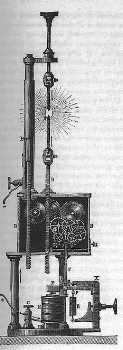
| |
 |
![]()
 Experimenting with arc lamps started in the early 1800's.
Experimenting with arc lamps started in the early 1800's.
The ultimate arc lamp is lightning, and so Benjamin Franklin's 1752 experiment of drawing electricity from the clouds and jumping a spark is perhaps the first arc lamp. In 1801 Humphry Davy observed the brilliant spark obtained when the connection between two carbon rods, attached to the poles of a battery, was broken. Some years later, in a demonstration lecture at the Royal Institution, he produced an arc nearly three inches in length. He used a voltaic battery with 2000 sets of plates, each four inches square. Commercial arc lighting had to wait for the development of dynamos such as the Gramme Machine in the early 1870s.
Experimentation moved to enclosing the arc in an air tight bulb to reduce consumption of the rods and regulating the current passing through the rods.
The earliest type of arc lamp was called the open arc because it was operated with the carbon electrodes exposed to the atmosphere. At the time of its introduction it was the most powerful artificial illuminant known and received much recognition. These earlier lamps had many disadvantages, the principal objections being the unsteadiness of the light and the rapid consumption of the carbons (it was not uncommon to replace the carbons every 8 to 10 burning hours). These lamps operated in series at about 50 volts, the number on a single lighting loop limited by the maximum voltage the central station generator could provide.
An improved type was introduced around the mid-1890s known as the enclosed arc where the electrodes operated within a glass globe. Since this inhibited the amount of air that could enter the arc, this had an immediate benefit of dramatically increasing the electrodes' life (typically 100-125 burning hours). The longer life of the electrodes outweighed the fact that these luminaries were less efficient than the open arc lamps. Both types of arc lamps are also known as "crater arcs". The tip of the positive electrode assumed the shape of a hollow crater and emitted about 90 percent of the light from the lamp, relatively little coming from the arc itself or the negative electrode.
It was found in later studies that certain chemicals could be combined with the carbon to form the electrodes that provided a highly luminous arc. This led to the development of the flame-carbon arc, so called because the arc stream provided most of the light. The efficiency of this type of lamp was three times that of the old open-arc lamp and about ten times that of the enclosed type.
Arc lamps operated best on circuits operated by special generators or transformers that closely regulated the circuit current at a constant value. In practice, most early series arc currents ranged from 4 to 10 amperes, but the most common circuits operated at 5.5, 6.6 or 7.5 amperes (6.6 amperes would later be established as the standard current for series circuits). The arc voltage of the various types of lamps ranged from 50 to 80 volts and since the lamps were connected in series, the voltage of the system depended on the number of lamps - in practice, the circuit would typically be operated at several thousand volts. These lamps were designed for operation on either direct current or alternating current circuits; the exception was the magnetite arc, which required direct current. In order to operate these magnetite arc lamp circuits, mercury-arc rectifiers were utilized to do the necessary conversion from AC to DC.
In a few rare cases, arc lamps were operated in multiple at secondary distribution voltages. Since the conductivity of the arc is non-linear, it increases greatly with increased current. As the arc heated up, the the ionized gases in the arc decreased in resistance allowing still more current to flow. This was a fundamental characteristic of all arc and electric discharge types of light sources. This is not an issue when operated in series as the power source holds the current at a constant value, however on multiple circuits, additional equipment is required to limit the current available and prevent a short-circuit arc. This additional equipment took the form of a resistance when used on DC circuits or a reactance coil when used on AC circuits, and often consumed just as much energy as the arc itself!